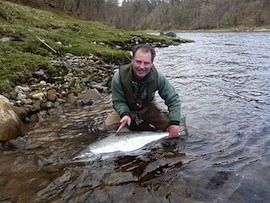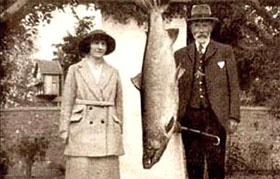
SCOTTISH salmon are growing bigger than they have for decades, according to experts.
Fish weighing 30lbs or more are becoming increasingly common on Scotland’s salmon rivers.
The largest fish this year was hooked on the river Tay earlier this month and tipped the scales at a hefty 40lb.
Specialists believe the monster catches are because fish are staying out in open-sea feeding grounds longer than normal.
Salmon normally go to sea after living in rivers for two to three years,
Those which return after just one year, known as grilse, typically weigh up to 8lbs.
But those which stay out at sea longer, usually two to three years, can weigh much more.
RAPID CHANGE
Typically the majority of fish in Scottish rivers are grilse but experts believe the balance is changing.
John Gibb, who manages a salmon fishery on the River Lochy in Inverness-shire, said large fish are being caught at a faster rate than any time in the last 30 years.
He said: “There has been a very rapid change in the last three to four years away from grilse abundance to proportionately far more two-to-three- winter fish.
“Hence we are getting more big fish. It’s very noticeable and really rather odd that we are getting these really quite enormous fish back into Scottish rivers.”
John believes the change is down to the rising temperature in the North Sea, which has forced the krill and sand eels eaten by salmon to move further north in search of cooler waters.
With further to travel to their feeding grounds, fish are staying out at sea far longer than before.
KNOCK-ON EFFECT
Fishing groups say anglers from across the globe are now flocking to Scottish rivers, enticed by the prospect of mammoth fish, generating more money for the economy.
But despite the influx of anglers looking to catch a gargantuan fish John believes the decline in grilse is worrying.
He said: “There are positives and negatives but I think on balance it’s probably negative because although we are getting these big fish, it’s a very concrete sign of global warming beginning to have a concrete knock-on effect.”
Dr David Summers, fisheries director at the Tay Salmon District fisheries board, said the increase in fish size has lead to some whoppers getting away as most anglers weren’t equipped to deal with heavier specimens.
He said: “The tackle they are using isn’t strong enough. The hooks bend. People are used to fishing for smaller fish.”
He agrees that there are more big fish entering Scottish rivers.
“It’s a good thing from an angling point of view because it adds a lot of interest,” he said.
“It’s certainly caused a fair bit of excitement, there’s no question of that.
“But at the same time the number of grilse is getting smaller. It’s symptomatic of the fact that perhaps conditions aren’t as good for grilse as they have been in the past.”
However some marine scientist believe that despite this year’s large catches, salmon are actually getting smaller.
Chris Todd, marine ecologist at the University of St Andrews said: “There may well be a few individual very big fish entering rivers and it’s very nice to see that but I don’t think they reflect an overall pattern.”
GEORGINA BALLANTINE

While the fish being landed are big by normal standards, they have some way to go to beat the all time record for a rod-caught salmon.
Georgina Ballantine, a ghillie’s daughter, landed a salmon weighing an astounding 64lb in October 1922.
The slightly build 32-year-old battled for two hours to bring in the monster after hooking it on the River Tay.
A sepia photograph from the time shows her posing in an immaculate tweed suit alongside the 54 inch fish.

